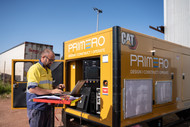Generator Load Testing | Your Guide
12th Aug 2022
When it comes to large-scale mining, industrial or construction operations, the quality of your generator is critical. Your generator can’t always be in use, so after standing idle or out of service for periods of time, you want to ensure that when you do need them, they can handle the load. Especially for crucial services in the event of an outage.
Regular load testing is the best way to guarantees the safe, reliable operation of your generator, eliminating the risk of the disruptive, inconvenient and unsafe occurrence of it failing.
Here’s everything you need to know about generator load testing, its benefits and why it’s essential for your mining, construction or industrial operation.
What is a Generator Load Test?
A generator load test is essentially a test run for the generator to ensure all its mechanics, functions and componentry are running as they should be. To do this, a load bank is used to simulate a power load on the generator to examine how it reacts in the event of a power outage.
The load bank will act as a substitute to the main grid, building or equipment loads to draw power from the generator for a set amount of time. By gradually increasing the power load, you are able to observe and record data from the generator until you reach maximum load.
When the diagnostics are run, it will record the performance data from the following:
- Oil temperature
- Oil pressure
- Fuel consumption
- Frequency
- Battery voltage
- Engine operating temperature
- Amperage
What is the Purpose of Generator Load Testing?
Generators need to be fully functioning and ready to perform optimally at any given time. A generator load test will shed light on any faults or problems with the generator or its cooling system. It also prevents wet-stacking and maintains general performance.
Generators also need to be able to perform that their highest load possible whenever needed and are commonly used as a critical power supply for the following:
- Healthcare & hospital facilities
- Data centres
- Large-scale mining operations
- Construction sites
- Commercial facilities
Whether it’s powering a worksite or providing critical power for data centres, hospitals or commercial buildings, a faulty generator can cause severe consequences. Load testing prevents identifying faults or problems at the worst possible time.
Scheduling regular load testing is critical as part of your ongoing generator maintenance program. Without it, you won’t be able to guarantee the optimal performance of the generator when you require emergency or back-up power.
How Do You Perform a Generator Load Test?
The aim every load test is to simulate power demand onto the generator. To do this, you need to gradually increase the power demand over set time frames. Each time the power demand increases the test measures and records the generators capability to handle power over time and at its highest capacity.
When the generator reaches 100% capacity, leave it run for a specified amount of time (usually a few hours or even a few days - but check the maintenance requirements). Performing a generator load test may vary, but it usually involves the following:
Step One: Performing a preliminary check - including checking the oil level, fuel tank, coolant tank and radiator.
Step Two: Start the generator and wait for it reach standard operation temperature. If any abnormalities occur, address them and discontinue the test.
Step Three: Begin administering the loads in increments.
Step Four: Once the generator reaches 100% capacity, monitor the performance. Lookout for overheating, strange noises while monitoring the power output. If problems arise, you should shut down the generator straight away and seek repair.
Step Five: Run the generator at full capacity for the recommended time (this can be anywhere from 2 to 24 hours depending on the generator type.) Some large industrial generators should be run for a few days.
Step Six: Once the test is complete, gradually lower the power demand, allowing the generator to run at a lighter load for an hour or so before it shutting down.
How Often Does a Generator Need Testing?
This largely depends on your generator application use and manufacturer recommendations. It is standard procedure to perform a generator load test at least once a year, especially if your generator is not used to carrying heavy loads on a regular basis. Even more so if your generator rarely exceeds more than 30% of its rated kW.
Backup and emergency generators used for healthcare facilities or hospitals may require more frequent testing under federal requirements. Here, you should always check with the corresponding guidelines for your application use - some requirements call for a 30min load test every month. On the other hand, some tests require at least one hours run time on an annual basis.
If you tend to run lighter loads for your generator more frequently, then consider testing more often. This will help avoid wet-stacking problems from occurring.
For more guidance on how often you should perform a generator load test, reach out to an expert team.
Why is Generator Load Testing Critical for Your Operation?
Above all else, scheduling regular generator load testing in your maintenance plan gives you peace of mind that your generator will perform optimally when you need it most. Here’s why generator load testing is critical to your operation:
- You remain compliant for generator testing - especially in emergency or critical applications such as medical facilities
- Prevents wet-stacking, extending the lifetime of the generator
- Guarantees generators are ready to use for maximum power loads
- Verifies the efficiency of the generator
- Helps flag any minor faults, problems or issues so it can be addressed accordingly
Need a Power Solution? Get the Right Advice.
With years of experience servicing the mining construction industries, Blue Diamond Machinery has the equipment you need and can rely on. We not only offer expert advice and industry-leading warranties, we provide an all-encompassing solution. We will customise and install your power solution to your specific power demand requirements, wherever you are. Get in touch with our team today.



